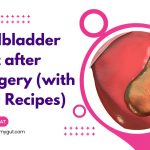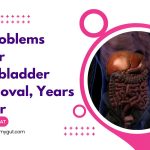Upper Right Abdominal Pain after Gallbladder Removal: 5 Causes, Gastroenterologist Explains.
Our content is not intended nor recommended as a substitute for medical advice by your doctor. Use for informational purposes only.
Pain in the upper right abdomen after gallbladder removal is common. The condition is known as (postcholecystectomy syndrome).
Postcholecystectomy syndrome is the presence of biliary colic or right upper abdominal pain after gallbladder removal (reference).
The Postcholecystectomy syndrome affects at least 10% of patients undergoing gallbladder removal (reference).
Possible causes of persistent upper-right abdominal pain are:
- Missed or recurrent gallstones inside the bile ducts.
- Surgical wound complications such as neuroma or infection.
- Injury to the gallbladder bed or bile ducts.
- Sphincter of Oddi dysfunction.
- Associated conditions include IBS, peptic ulcer disease, liver pain, right-sided pleurisy, rib cage pain, and pancreatitis.
1. Missed or recurrent stone in the bile ducts.
Stones often form inside the gallbladder. However, less commonly, a gallbladder stone can slip into the bile ducts before or during the surgery.
Bile duct stones (cholelithiasis) also can form inside the bile ducts (not the gallbladder). The formation of a new stone inside the bile duct can happen years after gallbladder removal.
Moreover, Missed stones inside bile ducts can cause persistent pain immediately after gallbladder removal.
Bile duct stones produce typical biliary-type pain with or without jaundice.
Jaundice (yellow eye whites, dark urine, and pale stool) is a sign of bile duct obstruction by a stone.
However, not all bile duct stones cause complete obstruction. So, biliary-type pain (in the upper right abdomen) can be the only symptom of a missed or newly-formed bile duct stone.
Symptoms:
- Biliary-type pain in the upper right abdomen. (described in the table below).
- Jaundice, dark urine, and pale (clay) stool may or may not be present.
- Associated symptoms such as nausea, vomiting, dyspepsia, and bloating.
| Biliary colic | Description |
| 1. Site | Usually, The right upper quadrant of your abdomen |
| 2. Spread | – The pain may spread to the back of the right shoulder. – Also, it spreads to the epigastric area. |
| 3. Character | Constant builds up then disappears gradually. |
| 4. Duration | At least 30 minutes. It may last up to 6 hours. |
| 5. Relation to food | – Triggered by foods (especially fatty food and large meals. – However, it can start spontaneously. |
| 6. NOT related to: | Movement, bowel movements, nor the passage of flatus. |
| 7. Nausea | Often Present, severe. |
| 8- Commonly associated symptoms | Vomiting, sweating during the attack. |
| 9. Unusual symptoms. | – Heartburn and chest pain. – Bloating, fullness. – Early satiety. – Isolated epigastric pain. |
| 10. Symptoms NOT associated: | – Fever. – Jaundice. – Prolonged pain for more than 6 hours. – Extreme tenderness over the gallbladder (Murphy’s sign). – Vomiting of blood, blackish stool (PUD). |
Complications of bile duct stones:
- Obstruction of bile ducts: causing jaundice, dark urine, and clay stool.
- Obstruction of the pancreatic ducts: causing gallstone pancreatitis.
- Infection and inflammations of the bile ducts (cholangitis) with fever and jaundice.
Missed bile duct stone needs you to consult your doctor. It is often diagnosed via abdominal ultrasonography.
2. Surgical wound complications.
There are two methods for gallbladder removal:
- Open cholecystectomy: a small 3-5 cm wound in the upper-right abdomen below the rib cage.
- Laparoscopic cholecystectomy: with three small wounds (one in the upper right abdomen).
Right upper abdominal pain after gallbladder removal can be a symptom of surgical wound complications.
Two main types of wound complications can explain the pain:
- Wound infection or seroma: causes upper-right abdominal pain shortly after gallbladder removal surgery (within hours to days).
- Wound neuroma: causes upper-right abdominal pain that can last for years.
Wound seroma is a sterile (non-infected) fluid collection under the skin in the wound area. Both infection and seroma occur in the first few days after the gallbladder removal surgery.
They are responsible for the early type of pain after gallbladder removal. Often they are obvious, and you can easily spot the infected or swollen wound.
Wound neuroma results from partial or complete nerve injury during the gallbladder removal operation. The nerve damage can result from a skin wound or gallbladder excision (amputation neuroma).
The damaged nerve can cause upper right abdominal pain that lasts for years.
Symptoms:
The pain from surgical wound complications is different from the typical biliary colic. Although it is in the same location in the upper-right abdomen, it has some differences:
- Not related to meals.
- Often accompanied by tenderness over the wound area.
- Constant pain (not in the form of attacks as gallbladder pain).
- Prolonged; it can last for years.
- Not affected by food or bowel movement.
- However, movement can increase the pain.
3. Injury to bile ducts or the gallbladder bed (with or without bile duct stricture).
During the operation, laceration or injury to the site of gallbladder attachment to the liver (gallbladder bed) may result in persistent abdominal pain.
The gallbladder bed can lead to minor or major bile leaks to the outside of the ducts (reference).
Minor leads can cause upper right abdominal pain for a few days after the operation and resolve spontaneously.
Major leads to complications such as bile fistulas, abscesses, or peritonitis (often, you will have severe abdominal pain, fever, and jaundice).
In the long term, bile duct injuries can lead to:
- Chronic inflammation and fibrosis at the gallbladder bed with prolonged upper-right abdominal pain.
- Bile duct strictures lead to partial or complete obstruction (it can lead to pain and jaundice).
4. Sphincter of Oddi dysfunction.
The common bile duct (CBD) delivers the bile to the duodenum. Then, the CBD unites the pancreatic duct near its end, forming a single duct called (the ampulla of Vater). The ampulla of Vater opens into the duodenum.

The opening is encircled by a ring of muscle called (the Sphincter of Oddi). Sphincter of Oddi dysfunction describes the abnormal obstruction of the bile and pancreatic secretions due to the abnormal structure of function of the Sphincter.
Sphincter of Oddi dysfunction mimics gallbladder pain. Therefore, the persistence of upper-right abdominal pain can be a sign of Sphincter of Oddi dysfunction.
It is rare and difficult to diagnose disease. Studies show that women are more affected by SOD than men (reference).
5. Associated conditions (Very common).
The pain in the upper right abdomen can be a sign of another disease or condition affecting your gut.
This is the most common and overlooked cause of pain after gallbladder removal (reference). Moreover, it is among the most common causes of (postcholecystectomy syndrome).
Possible associated conditions that can cause upper-right abdominal pain after gallbladder removal:
- Irritable bowel syndrome.’
- Peptic ulcer disease and chronic gastritis.
- Reflux esophagitis (acid reflux).
- Chronic pancreatitis.
- Psychiatric and neurological diseases.
Moreover, less common conditions can also lead to such types of pain after gallbladder removal:
- Intercostal Nerve inflammation (neuritis).
- Hepatitis.
- Liver or biliary tumors.
- Mesenteric ischemia.
- Diverticulitis.
- Unexplained pain syndromes.
The diagnosis of your specific cause of post-cholecystectomy pain is not easy. Therefore, your doctor often requires thorough medical evaluation and investigation.
Call your doctor if you are unsure about the cause of the pain.
MORE: Liver Complications after Bariatric Surgery.
- Evidence-based
- Written by a doctor.






